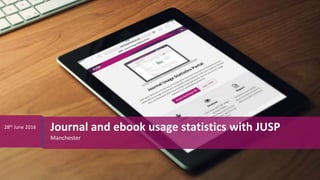
Workshop manchester-june2016
- 1. Manchester Journal and ebook usage statistics with JUSP28th June 2016
- 2. Morning Afternoon 2 » JUSP for Journals » How libraries use JUSP » Journal scenarios » Discussion » JUSP for ebooks » Ebook scenario » Discussion on ebook data » Future developments Workshop Agenda
- 3. Introductions Name Organisation Experience with JUSP Work with journals/books/both
- 6. What is JUSP? 6 JUSP gathers your usage data from multiple publishers and presents this in a single interface with a variety of reports and helpful functionality
- 7. What is JUSP? 7 JUSP gathers your usage data from multiple publishers and presents this in a single interface with a variety of reports and helpful functionality SUSHI COUNTER-compliant Participation agreement
- 8. Benefits of JUSP » Single point of access to journal and ebook usage data » Save time and duplicated effort » Simple way to analyse usage trends and provide evidence of value for money 8
- 10. JUSP in numbers »79 publishers and intermediaries supplying journal data › 10 also supplying ebook data »202 institutions across HE, FE, RC and other »305 million individual bits of journal data (2009-) »6 million individual bits of ebook data (2014-) »27 selectable reports for journals, 7 for ebooks A quick overview of what JUSP actually contains 10
- 11. Data collection and processing »All reports gathered are COUNTER-compliant, collected via SUSHI »Every report undergoes visual, manual and automatic checks »No data are added to JUSP without passing every check »Data are never altered but anomalies may be flagged »JUSP has its own SUSHI service providing access to quality- assured data for incorporation in 3rd party products/ERMs 11
- 12. What does JUSP do? 12 Publisher journal usage reports DOAJ KB+ core titles Deal title lists Journal level reports Summary reports Titles and deals reports Usage profiling KB+ Library systems SUSHI Intermediary journal usage reports SUSHI Portal COUNTER-compliant usage reports
- 13. JUSP for Journals Laura Wong
- 14. Journal reports 14 » Journal report 1 (JR1) - Number of successful full-text article requests by month and journal » Journal report 1a (JR1a) - Number of successful full-text article requests from an archive by month and journal » Journal report 1 GOA (JR1 GOA) - Number of successful Gold Open Access full-text article requests by month and journal COUNTER Code of Practice vendor generated data consistent compatible credible
- 15. JUSP for journals demo » Participating publishers » Welcome screen » Generating reports » Guides to reports 15
- 16. How libraries use JUSP Jo Alcock
- 17. How libraries use JUSP “obtaining usage data for multiple platforms when doing the SCONUL Return and conducting serials/subscription reviews” 17
- 18. How libraries use JUSP “Checking stats for our annual journals review - stats help the library and Faculty staff to assess value based on CPU* (although this is not the sole indicator used.)” *cost per use 18
- 19. How libraries use JUSP “I look at the reports on JUSP 2 or 3 times a year to get an indicator of how much journals across my Faculty are being used and report any concerns to relevant academics.” 19
- 20. How libraries use JUSP “I use JUSP to generate statistics such (as) most used titles and most used publishers. I display these on our website, to promote e- resource usage to university staff and students. ” 20
- 21. How libraries use JUSP http://www.jusp.mimas.ac.uk/use-cases/ http://www.jusp.mimas.ac.uk/events- training/ 21
- 22. Discussion on journal usage statistics What report(s) would you use if you need to provide evidence of value at short notice? How would you present this information? 22
- 23. Discussion on journal usage statistics What are the pros and cons of the individual title search? How is marking up core titles useful? What are the limitations? 23
- 24. Discussion on journal usage statistics What reports do/would you find most useful for determining overall usage of a deal and why? What other information would you use to inform any decisions? 24
- 25. Discussion on journal usage statistics How would/do you use the JUSP SCONUL return report in your preparation for the SCONUL return? If you don’t submit to the SCONUL return, how might you use this summary report? 25
- 26. Discussion on journal usage statistics What steps would you take if you found anomalies in your data? For example, a large spike in usage in a particular month. 26
- 27. 16/05/2016 27
- 29. JUSP for Books Jo Alcock
- 30. Book reports 30 » Book report 1 (BR1) - Number of successful title requests by month and title » Book report 2 (BR2) - Number of successful section requests by month and title » Book report 3 (BR3) - Access denied to content items by month, title and category COUNTER Code of Practice vendor generated data consistent compatible credible
- 31. Which publishers? Participating publishers and available reports http://jusp.mimas.ac.uk/participants/ 31
- 32. Demo » Accessing book portal » Generating reports » Book reports » Summary reports 32
- 33. Discussion on ebooks usage statistics » What is your institution currently doing with ebook usage statistics? Draw a picture representing your current processes with ebook data 33 » Where are the gaps or missing pieces in your pictures/processes? Is there anything you would do differently?
- 34. 34
